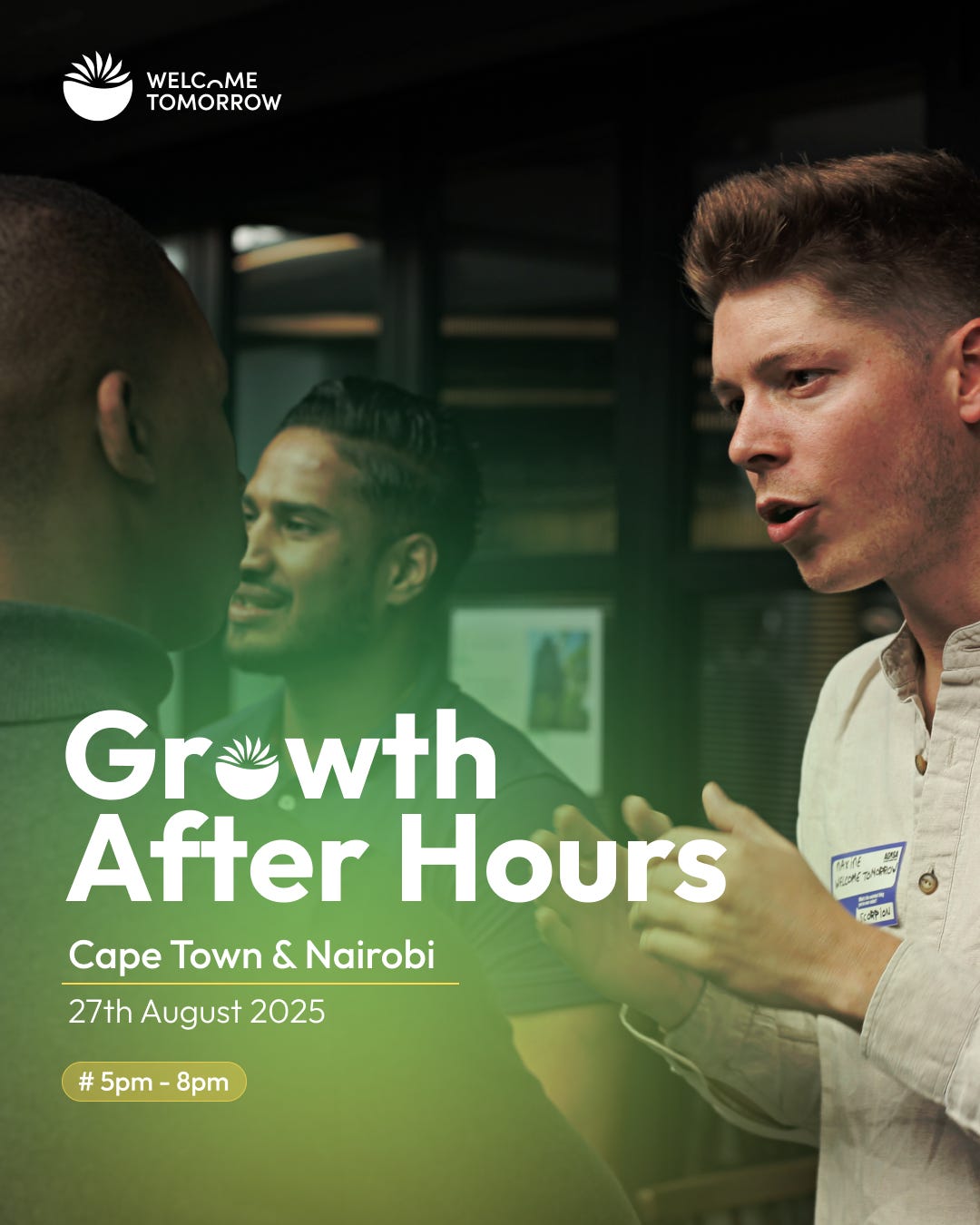How to Ethically Spy on Your Competitors’ Ads 🕵🏽♀️
Welcome to your latest edition of Welcome Tomorrow Insights, your go-to source for the latest in growth marketing strategies and impactful industry updates.
TL;DR:
Every keyword they bid on reveals the audiences they’re chasing and the positions they want to own in the market.
Every ad they launch is a real-time experiment, showing you which hooks, offers, and CTAs they believe are strong enough to scale.
Every landing page tweak signals how they think conversions happen what they change, keep, or emphasise tells you what’s working for them.
Every shift in visibility hints at their budget moves, from new launches to moments when they quietly pull back.
The advantage isn’t in copying, it’s in recognising these signals, learning faster than they do, and using their spend to sharpen your own strategy.
Want to take the conversation offline? Join us for Growth After Hours in Nairobi & Cape Town on the 27th of August.
Every brand is fighting for visibility on Google & Meta and in most industries, your biggest competition is just one search result away.
The truth is, your competitors are giving away valuable information every day: the keywords they’re bidding on, the copy they believe will convert, the landing pages they’re testing, and the signals that hint at where their budgets are moving.
If you know where to look, you can learn a lot.
This guide breaks down 10 simple, ethical ways to study what your competitors are doing on Google & Meta and use those insights to run smarter campaigns of your own.
Let’s dive in, shall we? 😊
1. Competitor Keyword Discovery
Competitor keywords reveal how they position themselves and what they value most.
How to do it:
Use Google Keyword Planner: enter a competitor’s URL to uncover related paid keywords (requires an active Google Ads account with billing enabled).
Use SEMrush or Ahrefs to pull competitor keyword lists.
Compare overlapping and unique terms to identify market gaps.
Tips: Filtering by “Top of Page Bid (high)” or by search volume (>500) helps isolate high-intent opportunities. Seeding Keyword Planner with a homepage or landing page often surfaces keywords competitors rely on.
2. Competitor Ad Copy Analysis
Ad copy reveals positioning, value propositions, and testing priorities.
How to do it:
Use the Google Ads Transparency Center to view all active ads linked to a competitor’s domain.
Track changes using tools like Visualping or by archiving screenshots.
Tips: Note recurring CTAs (“Sign Up Free,” “Request a Demo”) and link them back to on-site offers. Analysing changes over time highlights which messages they scale and which they abandon.
3. Audience Targeting Insights
Creative choices often indicate who a campaign is designed for.
How to do it:
In Meta Ad Library, study the ad copy and visuals ,references like “for SMEs,” “for first-time home buyers,” or “for parents” are clear audience signals. The “See ad details” tab also shows where the ad runs (e.g., Instagram Stories, Facebook Feed).
In the Google Ads Transparency Center, check the formats (Search, YouTube, Display) and countries where a competitor’s ads appear, this gives clues about their geographic and channel focus.
Run manual searches in Google for relevant terms and note which competitors consistently show up. Their presence on certain queries tells you which audiences they’re prioritising.
Tips: Audience signals don’t always come from explicit targeting data, often it’s in the language, imagery, and offers they choose. Cross-check these cues with your own top-converting audiences to sharpen your segmentation.
4. Bid Strategy Evaluation
Auction data reveals how assertively competitors pursue visibility.
How to do it:
Within your Google Ads account, run Auction Insights on branded and non-branded terms.
Segment results by device, geography, or time of day for more context.
Tips: Metrics such as Overlap Rate and Outranking Share indicate whether competitors are prioritising visibility. Sudden shifts often point to campaign launches or reallocation of spend.
5. Ad Extensions Utilisation
Extensions showcase the features and benefits competitors believe will increase click-through.
How to do it:
Search competitor brand names in Google to see active sitelinks, callouts, structured snippets, and pricing extensions.
Use the Transparency Center for additional context across campaigns.
Tips: Keep a record of extensions over time to identify recurring themes. Structured Snippets often reveal the unique selling points competitors rely on.
6. Landing Page Analysis
The post-click experience is as critical as the ad itself.
How to do it:
In Meta Ad Library, most ads allow you to click through directly to the live landing page, giving you a real-time view of the funnel.
In the Google Ads Transparency Center, you’ll usually see the ad creative and destination domain. Sometimes you can click through, but often the final landing page isn’t provided so it’s less reliable for direct access.
To understand how landing pages evolve over time, you’ll need tools that archive older versions or give traffic context. These aren’t perfect, but they provide enough history to spot seasonal campaigns or major shifts.
Browsing in incognito or via a VPN can reveal geo-specific versions competitors may be testing.
Tips:
Look at how competitors structure their pages: the main hook, offer, and CTA placement. Over time, patterns like repeated use of urgency, discounts, or tiered pricing show you what they believe drives conversions.
7. Tracking & Analytics Review
Tracking tags provide insight into how competitors structure their funnel not their results.
How to do it:
Use free Chrome extensions like Google Tag Assistant and Meta Pixel Helper to see which tracking tags are implemented.
Tips: By examining confirmation pages, you can infer which actions are considered conversions (e.g., lead, signup, purchase). You cannot see performance data, but you can identify which events matter most to them.
8. Seasonal Trends Monitoring
Seasonal behaviour reveals when competitors concentrate resources.
How to do it:
Use Google Trends to track brand vs category demand over time.
Check ad archives for launches that repeat at the same time each year.
Watch search results on seasonal queries, consistent visibility is a stronger signal than a brief appearance.
Look for on-site promos (banners, countdowns, codes) that often accompany real seasonal pushes.
Tips: Creative bursts alone don’t prove seasonality, they could just be tests. Focus on repeated timing and sustained presence across multiple signals. Analyse at least five years of data to identify recurring peaks, this makes it easier to predict when competitors are likely to escalate campaigns in the future.
9. Strategic Budget Signals
While you cannot access competitor budgets directly, certain signals reveal how spending is shifting.
How to do it:
On Google Ads, monitor Auction Insights. Significant increases in impression share typically indicate higher budgets or new campaigns. Declines often reflect budget cuts or strategic reallocation.
On Meta, the Ad Library shows when brands release large volumes of new creatives. This can indicate a new campaign push, but it is not proof of increased spend, budgets can remain constant while ads are simply divided across more variations.
Tips: Stronger evidence emerges when signals overlap. For example, a surge in creatives on Meta combined with higher impression share on Google strongly suggests increased investment.
10. Reporting & Insights Compilation
Insights only create value if they are tracked and applied.
How to do it:
Build a structured Google Sheet or Looker dashboard to record ad changes, keyword activity, landing page updates, and Auction Insights results.
Review and share findings on a weekly or bi-weekly basis.
Tips: Organise changes by theme (offer shifts, new audience angles, creative directions). Maintain a swipe file of ad copy and creative concepts to inform your own testing.
🤝🏾 Final Take away
Your competitors are already giving you a window into their strategy , every keyword they chase, every ad they publish, every landing page they adjust.
You don’t need to reinvent the wheel. Pay attention to what they’re doing, capture the signals, and use that information to make smarter choices for your own campaigns.
The goal isn’t to copy them. It’s to learn faster than they do, spot opportunities they miss, and stay one step ahead.
That’s how you turn competitor spend into your own advantage, not by reacting to every move, but by building a system that keeps you learning and improving, week after week.
📅 Come hang with us at Growth After Hours Next Week 🥂
You know our Growth Labs where we dig into one big topic?
This is the more relaxed version, a networking evening happening on 27th August in Nairobi and Cape Town.
No slides, no pressure, Just good people, good chats, and a chance to swap stories, ideas, and maybe even meet your next collaborator or client over a drink. 🍹
Looking forward to seeing you there 👋🏾
Join Our Community 👥
Check out the blog, follow along on socials, and stay in the loop as we share the wins, lessons, and experiments shaping growth marketing today. 🤝🏾
PS: The really good stuff? You’ll find that on our TikTok. 👀😂
We’re Your Growth Partner 🤝🏾
Tell us where you are and where you want to be ,and we’ll help get you there.




